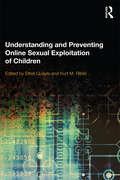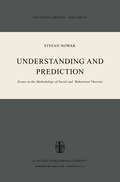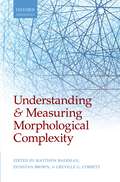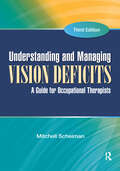- Table View
- List View
Understanding and Preventing Recidivism of Young Offenders in Argentina (SpringerBriefs in Criminology)
by Mirian Susana Orlando David P. FarringtonThis book aims to advance knowledge about the recidivism of young offenders. It reviews knowledge about risk factors for recidivism and about protective factors that encourage desistance. It then reviews quantitative research on predictors of recidivism versus desistance of young offenders in Buenos Aires, Argentina, based on following up over 100 young offenders during a two-year statutory monitoring period. Numerous factors are identified that predict recidivism: family, educational, social, community, demographic, offence history, substance use history. It then presents qualitative research based on offenders’ narratives, using extensive verbatim quotations, that explain their recidivism versus desistance. Finally, it reviews research on the prevention of recidivism of young offenders and makes recommendations based on the quantitative and qualitative analyses. This book should be of great interest to all academics, researchers, practitioners and policy makers who are interestedin juvenile offending and recidivism, including criminologists, psychologists, psychiatrists, social scientists and criminal justice practitioners.
Understanding and Preventing Online Sexual Exploitation of Children
by Ethel Quayle Kurt M. RibislOver the last decade there has been dramatically increased interest in the ways that technology has been used in the abuse and exploitation of children, due in part to increasing numbers of convictions for child pornography-related offenses. Opinion swings between those who feel that there is a danger of distorting the threat posed to children by technology, and those for whom it appears that the threat has been grossly underestimated. Current literature surrounding the debate at times seems to create more questions than answers and what quickly becomes apparent is that the data we have to inform our understanding is partial, potentially context specific, and at times seemingly contradictory. This book broadens our understanding of the complex nature of online sexual exploitation of children and considers the risk that those engaged in Internet-related offences pose to children in both the online and offline environments. It focuses on cutting-edge research and conceptual thinking that views perpetrators within context, examines those impacted by such offending, describes emerging legal and policy issues, and proposes innovative strategies for prevention within a dynamic global environment. Understanding and Preventing Online Sexual Exploitation of Children responds to the growing call for help across all practice areas, from judicial to therapeutic, and will provide an invaluable resource for practitioners and policy makers working in the field, as well as students and academics studying sexual exploitation and cyber crime.
Understanding and Preventing Online Sexual Exploitation of Children
by Ethel Quayle Kurt M. RibislOver the last decade there has been dramatically increased interest in the ways that technology has been used in the abuse and exploitation of children, due in part to increasing numbers of convictions for child pornography-related offenses. Opinion swings between those who feel that there is a danger of distorting the threat posed to children by technology, and those for whom it appears that the threat has been grossly underestimated. Current literature surrounding the debate at times seems to create more questions than answers and what quickly becomes apparent is that the data we have to inform our understanding is partial, potentially context specific, and at times seemingly contradictory. This book broadens our understanding of the complex nature of online sexual exploitation of children and considers the risk that those engaged in Internet-related offences pose to children in both the online and offline environments. It focuses on cutting-edge research and conceptual thinking that views perpetrators within context, examines those impacted by such offending, describes emerging legal and policy issues, and proposes innovative strategies for prevention within a dynamic global environment. Understanding and Preventing Online Sexual Exploitation of Children responds to the growing call for help across all practice areas, from judicial to therapeutic, and will provide an invaluable resource for practitioners and policy makers working in the field, as well as students and academics studying sexual exploitation and cyber crime.
Understanding and Preventing Falls: A Guide to Reducing Your Risks
by Stephen Z. FademDespite the fact that elderly persons have a 33-35% chance of falling and becoming injured, most are ill-prepared. According to the World Health Organization, falls cause over 50% of accidental injuries and 39% of fatal injuries in the elderly. They are the fifth leading cause of death in the general population. Falls can be either non-mechanical, related to underlying illness or debilitation, or they can be mechanical, related to accidental trips and slips and caused by environmental factors such as poor lighting, surprise steps, lack of grab bars, and slippery bathroom floors. Non-mechanical falls can be related to cognitive disorders, such as stroke or dementia, or to frailty. They can also be related to over-medicating with sedatives, diabetic medications, or blood pressure therapy. Falls can be the consequence of aging or chronic diseases such as heart disease, diabetes, kidney disease, or cancer. Patients with any of these disorders may have poor muscle tone, walking disorders, or a loss of equilibrium. Mechanical falls may be completely avoided by fall-proofing the home environment. This book outlines several practical tips for eliminating potential home hazards and reviews each of the major causes of falls to help the patient and his or her caregiver, as well as the health provider, prevent falling by adapting one's lifestyle. The book also covers exercise programs and community programs that can be established and used to minimize the risk of falling in the elderly. Given that falls are common and that the majority of persons who fall are ill-prepared, this book will raise awareness of fall-prevention measures that can help reduce falls and fall-related injuries.
Understanding and Preventing Faculty-on-Faculty Bullying: A Psycho-Social-Organizational Approach
by Darla J. TwaleUnderstanding and Preventing Faculty-on-Faculty Bullying provides a comprehensive understanding of workplace harassment, aggression, violence, bullying, and incivility in academia. Using a psychological, sociological, and organizational approach, this book explores the issue from the perspective of the individual, the department, and from the higher education organization. Providing research on the effects on victims and collegial culture, this important volume brings together interdisciplinary scholarship to present research-based suggestions for recovering from workplace bullying, recommendations for improving toxic academic environments, and practical advice about policy development to improve academic organizational culture and climate.
Understanding and Preventing Faculty-on-Faculty Bullying: A Psycho-Social-Organizational Approach
by Darla J. TwaleUnderstanding and Preventing Faculty-on-Faculty Bullying provides a comprehensive understanding of workplace harassment, aggression, violence, bullying, and incivility in academia. Using a psychological, sociological, and organizational approach, this book explores the issue from the perspective of the individual, the department, and from the higher education organization. Providing research on the effects on victims and collegial culture, this important volume brings together interdisciplinary scholarship to present research-based suggestions for recovering from workplace bullying, recommendations for improving toxic academic environments, and practical advice about policy development to improve academic organizational culture and climate.
Understanding and Preventing Corruption (Crime Prevention and Security Management)
by A. Graycar T. PrenzlerGraycar and Prenzler present a readily accessible guide to the issues of public and private sector corruption, outlining the nature and dimensions of corruption problems in a variety of settings across the world, and providing a set of practical strategies to prevent corruption that also facilitate economic growth and development.
Understanding and Preventing Community Violence: Global Criminological and Sociological Perspectives
by James F. Albrecht Garth Den HeyerThis book examines the contemporary rise in community violence across the United States and globally from sociological and criminological perspectives. It comprehensively investigates police response to criminal incidents, engagements with criminal suspects, use of force by law enforcement, and crime control measures implemented or recommended to initiate effective crime control measures so that the unwanted rise of violence and serious crime can again be contained. The primary audience for the book will be upper level undergraduate and graduate level students, criminal justice and law enforcement practitioners, government policy makers, community advocates, and researchers in sociology, criminology, homeland security, criminal justice, public administration, and political science.
Understanding and Prediction: Essays in the Methodology of Social and Behavioural Theories (Synthese Library #94)
by S. NowakOne of the more characteristic features of contemporary sociology is an increasing interest in theories. More and more theories are being developed in various areas of social investigation; we observe also an increasing number of verificational studies aimed primarily toward the verification of various theories. The essays presented in this volume deal with theories too, but they approach this problem from a methodological perspective. There fore it seems worthwhile in the preface to this volume to make a kind of general declaration about the author's aims and his approach to the subject of his interest, and about his view of the role of methodological reflection in the development of sciences. First let me say what methodology cannot do. It cannot be a substitute for the formulation of substantive theories, nor can it substitute for the empirical studies which confirm or reject such theories. Therefore its impact upon the development of any science, including the social sciences, is only indirect, by its undertaking the analysis of research tools and rules of scientific procedures. It can also propose certain standards for scientific procedures, but the application of these standards is the domain of substan tive researchers, and it is the substantive researchers who ultimately develop any science. Nevertheless the potential impact-of methodological reflection, even if only indirect, should not be underestimated.
Understanding and Paying Less Property Tax For Dummies
by Steve SimsThis comprehensive guide to understanding and paying less property tax for dummies is the best-value beginners book on the market. Covering everything from commercial buy-to-let and jet-to-let to property development and investing through a company, it explains a notoriously confusing subject in straightforward and easy to follow language. Packed full of tax saving tips and strategies, Understanding and Paying Less Tax For Dummies will help British property owners and investors minimise their tax bills and maximise their returns.
Understanding and Paying Less Property Tax For Dummies
by Steve SimsThis comprehensive guide to understanding and paying less property tax for dummies is the best-value beginners book on the market. Covering everything from commercial buy-to-let and jet-to-let to property development and investing through a company, it explains a notoriously confusing subject in straightforward and easy to follow language. Packed full of tax saving tips and strategies, Understanding and Paying Less Tax For Dummies will help British property owners and investors minimise their tax bills and maximise their returns.
Understanding and Negotiating EPC Contracts, Volume 2: Annotated Sample Contract Forms
by Howard M. SteinbergAny project which involves an EPC contract is also likely to involve a number of other complicated contracts. The challenge of the parties to an EPC contract is not to try to eliminate risk but rather put into place a narrative structure that enables the parties to predict the contractual result that would obtain if a risk materializes. If the EPC contract does not allow the parties to determine the consequences of an unanticipated situation, they will have to look to an expert, mediator, tribunal, or court to impart guidance or pass judgment. The sample forms of contract contained in Volume 2 of Understanding and Negotiating EPC Contracts are intended to serve as a guide to demonstrate how risks and responsibilities can be allocated among project sponsors, EPC contractors and the various other parties that may be involved in a project. Collectively the sample forms in this volume offer an extraordinary resource that provides the benefit of lessons learned and priceless insight into any project being undertaken which can help assure the resilience of any EPC project.
Understanding and Negotiating EPC Contracts, Volume 2: Annotated Sample Contract Forms
by Howard M. SteinbergAny project which involves an EPC contract is also likely to involve a number of other complicated contracts. The challenge of the parties to an EPC contract is not to try to eliminate risk but rather put into place a narrative structure that enables the parties to predict the contractual result that would obtain if a risk materializes. If the EPC contract does not allow the parties to determine the consequences of an unanticipated situation, they will have to look to an expert, mediator, tribunal, or court to impart guidance or pass judgment. The sample forms of contract contained in Volume 2 of Understanding and Negotiating EPC Contracts are intended to serve as a guide to demonstrate how risks and responsibilities can be allocated among project sponsors, EPC contractors and the various other parties that may be involved in a project. Collectively the sample forms in this volume offer an extraordinary resource that provides the benefit of lessons learned and priceless insight into any project being undertaken which can help assure the resilience of any EPC project.
Understanding and Negotiating EPC Contracts, Volume 1: The Project Sponsor's Perspective
by Howard M. SteinbergIn Understanding and Negotiating EPC Contracts, Volume 1, Howard M. Steinberg presents a practical and comprehensive guide to understanding virtually every aspect of engineering, procurement and construction (EPC) contracts for infrastructure projects. The 25 chapters in Volume 1 are supplemented with real-life examples and court decisions, and offer tactical advice for anyone who must negotiate or understand EPC contracts in connection with the implementation, financing or operation of infrastructure projects. Emphasizing current market practices and strategic options for risk sharing, the book contains a narrative explanation of the underpinning of all of the issues involved in EPC contracting. Exhaustive in scope, it clarifies the fundamental commercial principles and pitfalls of "turnkey" contracting for all types of capital investments ranging from electrical and thermal power generation (including combined heat and power, nuclear, wind, solar, natural gas and coal) to refining, to chemical processing to LNG liquefaction and re-gasification to high speed rail, bridging, tunneling and road building. Providing clear and thorough analyses of the issues and challenges, this volume will be of great value to all those involved in complex construction projects.
Understanding and Negotiating EPC Contracts, Volume 1: The Project Sponsor's Perspective
by Howard M. SteinbergIn Understanding and Negotiating EPC Contracts, Volume 1, Howard M. Steinberg presents a practical and comprehensive guide to understanding virtually every aspect of engineering, procurement and construction (EPC) contracts for infrastructure projects. The 25 chapters in Volume 1 are supplemented with real-life examples and court decisions, and offer tactical advice for anyone who must negotiate or understand EPC contracts in connection with the implementation, financing or operation of infrastructure projects. Emphasizing current market practices and strategic options for risk sharing, the book contains a narrative explanation of the underpinning of all of the issues involved in EPC contracting. Exhaustive in scope, it clarifies the fundamental commercial principles and pitfalls of "turnkey" contracting for all types of capital investments ranging from electrical and thermal power generation (including combined heat and power, nuclear, wind, solar, natural gas and coal) to refining, to chemical processing to LNG liquefaction and re-gasification to high speed rail, bridging, tunneling and road building. Providing clear and thorough analyses of the issues and challenges, this volume will be of great value to all those involved in complex construction projects.
Understanding and Negotiating Construction Contracts: A Contractor's and Subcontractor's Guide to Protecting Company Assets
by Kit WerremeyerUnderstanding and Negotiating Construction Contracts The complexities of construction contracts are made easy with this thorough and readable guide Construction contracts can be complex for both owners and contractors. For contractors, negotiating fair and balanced commercial terms in contracts is just as important as properly managing projects; a properly negotiated contract can mitigate unnecessary risk and unnecessary risk transfer. This, in turn, reduces exposure to financial liability for the contractor and for avoidance of contract claims and disputes. Understanding and Negotiating Construction Contracts provides a comprehensive and readable introduction to the world of construction contracts. Providing, for example, coverage of the four most common types of contracts—lump sum/fixed-price, cost-plus, time-and-materials, and unit-pricing—it promises to reduce uncertainty and allow contractors to enter contractual negotiations with greater confidence to be able to achieve a fair and balanced contract. This updated new edition reflects the up-to-date best practices to understand how to better negotiate the commercial terms and conditions in construction contracts. Readers of the second edition of Understanding and Negotiating Construction Contracts will also find: Updated information on indemnity, insurance, and negotiation An all-new chapter with a contract analysis checklist Real-world examples drawn from small residential, retail, large commercial, and international projects Understanding and Negotiating Construction Contracts is essential for construction professionals and college students studying construction contracts and the liabilities arising out of them.
Understanding and Negotiating Construction Contracts: A Contractor's and Subcontractor's Guide to Protecting Company Assets
by Kit WerremeyerUnderstanding and Negotiating Construction Contracts The complexities of construction contracts are made easy with this thorough and readable guide Construction contracts can be complex for both owners and contractors. For contractors, negotiating fair and balanced commercial terms in contracts is just as important as properly managing projects; a properly negotiated contract can mitigate unnecessary risk and unnecessary risk transfer. This, in turn, reduces exposure to financial liability for the contractor and for avoidance of contract claims and disputes. Understanding and Negotiating Construction Contracts provides a comprehensive and readable introduction to the world of construction contracts. Providing, for example, coverage of the four most common types of contracts—lump sum/fixed-price, cost-plus, time-and-materials, and unit-pricing—it promises to reduce uncertainty and allow contractors to enter contractual negotiations with greater confidence to be able to achieve a fair and balanced contract. This updated new edition reflects the up-to-date best practices to understand how to better negotiate the commercial terms and conditions in construction contracts. Readers of the second edition of Understanding and Negotiating Construction Contracts will also find: Updated information on indemnity, insurance, and negotiation An all-new chapter with a contract analysis checklist Real-world examples drawn from small residential, retail, large commercial, and international projects Understanding and Negotiating Construction Contracts is essential for construction professionals and college students studying construction contracts and the liabilities arising out of them.
Understanding and Modeling Förster-type Resonance Energy Transfer: FRET-Applications, Vol. 3 (SpringerBriefs in Applied Sciences and Technology)
by Hilmi Volkan Demir Pedro Ludwig Hernández Martínez Alexander GovorovThis Brief will focus on the functional uses and applications of FRET, starting with the derivation of FRET in the assemblies of nanostructures and subsequently giving application cases for biologists, physicists, chemists, material scientists, engineers, and those in many other fields whoever would like to FRET as a tool. The goal of this part is therefore to show both specialist and non-specialist how to use and analyze FRET in a wide range of applications.
Understanding and Modeling Förster-type Resonance Energy Transfer: Introduction to FRET, Vol. 1 (SpringerBriefs in Applied Sciences and Technology)
by Alexander Govorov Pedro Ludwig Hernández Martínez Hilmi Volkan DemirThis Brief presents a historical overview of the Förster-type nonradiative energy transfer and a compilation of important progress in FRET research, starting from Förster until today, along with a summary of the current state-of-the-art. Here the objective is to provide the reader with a complete account of important milestones in FRET studies and FRET applications as well as a picture of the current status.
Understanding and Modeling Förster-type Resonance Energy Transfer: FRET from Single Donor to Single Acceptor and Assemblies of Acceptors, Vol. 2 (SpringerBriefs in Applied Sciences and Technology)
by Pedro Ludwig Hernández Martínez Alexander Govorov Hilmi Volkan DemirThis Brief presents a complete study of the generalized theory of Förster-type energy transfer in nanostructures with mixed dimensionality. Here the aim is to obtain a generalized theory of FRET including a comprehensive set of analytical equations for all combinations and configurations of nanostructures and deriving generic expressions for the dimensionality involved. In this brief, the modification of FRET mechanism with respect to the nanostructure serving as the donor vs. the acceptor will be included, focusing on the rate’s distance dependency and the role of the effective dielectric function in FRET, which will be a unique, useful source for those who study and model FRET.
Understanding and Measuring Morphological Complexity
This book aims to assess the nature of morphological complexity, and the properties that distinguish it from the complexity manifested in other components of language. Of the many ways languages have of being complex, perhaps none is as daunting as what can be achieved by inflectional morphology: this volume examines languages such as Archi, which has a 1,000,000-form verb paradigm, and Chinantec, which has over 100 inflection classes. Alongside this complexity, inflection is notable for its variety across languages: one can take two unrelated languages and discover that they share similar syntax or phonology, but one would be hard pressed to find two unrelated languages with the same inflectional systems. In this volume, senior scholars and junior researchers highlight novel perspectives on conceptualizing morphological complexity, and offer concrete means for measuring, quantifying and analysing it. Examples are drawn from a wide range of languages, including those of North America, New Guinea, Australia, and Asia, alongside a number of European languages. The book will be a valuable resource for all those studying complexity phenomena in morphology, and for theoretical linguists more generally, from graduate level upwards.
Understanding and Managing Your Child's Food Allergies (A Johns Hopkins Press Health Book)
by Scott H. SichererFor children with food allergies, eating—one of the basic functions of life—can be a nightmare. Children who suffer or become dangerously ill after eating peanuts, seafood, milk, eggs, wheat, or a host of other foods require constant vigilance from caring, concerned parents, teachers, and friends.In this empathetic and comprehensive guide, Dr. Scott H. Sicherer, a specialist in pediatric food allergies, gives parents the information they need to manage their children’s health and quality of life. He describes why children develop food allergy, the symptoms of food allergy (affecting the skin, the gastrointestinal tract, and the respiratory system), and the role of food allergy in behavioral problems and developmental disabilities. Parents will learn how to recognize emergency situations, how to get the most out of a visit with an allergist, what allergy test results mean, and how to protect their children—at home, at school, at summer camp, and in restaurants.Informative, compassionate, and practical, this guide will be indispensable for parents, physicians, school nurses, teachers, and everyone else who cares for children with food allergies.
Understanding and Managing Vision Deficits: A Guide for Occupational Therapists
by Mitchell ScheimanThe Third Edition of Understanding and Managing Vision Deficits is the go-to resource that will enable occupational therapists to develop a comprehensive understanding of vision, appreciate the various effects vision problems can have on the practice of occupational therapy, and to more effectively manage patients with vision disorders.Understanding and Managing Vision Deficits: A Guide for Occupational Therapists, Third Edition is a unique collaboration from occupational therapists, optometrists, and low vision rehabilitation specialists.Dr. Mitchell Scheiman presents a unique Three Component Model of Vision that includes: Visual integrity: Includes visual acuity (clarity), the optics of the eye, and eye health Visual efficiency skills: Includes focusing, eye teaming, and eye movements Visual information processing skills: Includes the ability to analyze, interpret and respond to visual information A major emphasis of the new edition is on management of eye movement, visual information processing, visual field, and low vision problems. Therapy suggestions have been expanded and the use of computer software has been incorporated into the therapy.Some Additional Chapter Topics Include: Visual problems associated with learning disorders Visual problems associated with acquired brain injury Management of vision problems for children with special needs Low vision Features of the Third Edition: Updated figures, research, and references Incorporates current American Occupational Therapy Association Practice Framework Glossary of key terms Appendices that include a vision screening report form and low vision supplies and equipment Understanding and Managing Vision Deficits: A Guide for Occupational Therapists, Third Edition will continue to bring the professions of occupational therapy and optometry together and will guide health care professionals to provide the ultimate in patient care.
Understanding and Managing Vision Deficits: A Guide for Occupational Therapists
by Mitchell ScheimanThe Third Edition of Understanding and Managing Vision Deficits is the go-to resource that will enable occupational therapists to develop a comprehensive understanding of vision, appreciate the various effects vision problems can have on the practice of occupational therapy, and to more effectively manage patients with vision disorders.Understanding and Managing Vision Deficits: A Guide for Occupational Therapists, Third Edition is a unique collaboration from occupational therapists, optometrists, and low vision rehabilitation specialists.Dr. Mitchell Scheiman presents a unique Three Component Model of Vision that includes: Visual integrity: Includes visual acuity (clarity), the optics of the eye, and eye health Visual efficiency skills: Includes focusing, eye teaming, and eye movements Visual information processing skills: Includes the ability to analyze, interpret and respond to visual information A major emphasis of the new edition is on management of eye movement, visual information processing, visual field, and low vision problems. Therapy suggestions have been expanded and the use of computer software has been incorporated into the therapy.Some Additional Chapter Topics Include: Visual problems associated with learning disorders Visual problems associated with acquired brain injury Management of vision problems for children with special needs Low vision Features of the Third Edition: Updated figures, research, and references Incorporates current American Occupational Therapy Association Practice Framework Glossary of key terms Appendices that include a vision screening report form and low vision supplies and equipment Understanding and Managing Vision Deficits: A Guide for Occupational Therapists, Third Edition will continue to bring the professions of occupational therapy and optometry together and will guide health care professionals to provide the ultimate in patient care.
Understanding and Managing Vaccine Concerns (SpringerBriefs in Public Health #0)
by Julie A. Boom Rachel M. CunninghamSmallpox, measles, diphtheria, polio: vaccines have diminished their power, and in some cases, eradicated these dreaded diseases. Yet this century has seen growing numbers of parents refusing vaccinations for their children, not only endangering them but also increasing the risk of outbreaks and epidemics of vaccine-preventable diseases.Understanding and Managing Vaccine Concerns concisely explains the evolution of vaccine concerns, and gives clinicians hands-on help in dealing with vaccine hesitation and outright refusal among parents. Persistent themes in refusal, such as a supposed autism/vaccine link and the belief that too many vaccines are given too soon, are discussed and recent statistics given for trends in vaccine refusal and delay. Central to the book is a detailed guide to vaccine concern management, with sample responses that readers can tailor to address vaccine refusal and specific concerns regarding individual vaccines and their components. This thorough grounding will assist providers in countering misinformation with facts and allaying fears with medically and ethically sound responses. Included in this practical resource:A brief history of vaccine concerns.Current trends in vaccine hesitancy and refusal.Health implications of vaccine refusal.Characteristics and beliefs of vaccine-concerned parents.The CASE approach: a management strategy for vaccine concerns.Additional considerations in management strategies.The debate over vaccination isn't going away any time soon and neither is the potential threat to public health, making Understanding and Managing Vaccine Concerns a timely and necessary addition to the libraries of pediatricians, nurses and other healthcare providers.

















